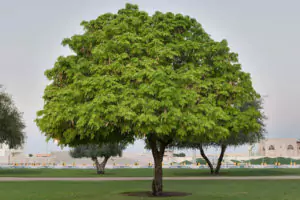Vagai Maram
The Vagai tree (Albizia lebbeck), also known as the Siris or East Indian walnut, is a large deciduous tree belonging to the Fabaceae family. Known as "Vagai Maram" in Tamil, this tree is native to tropical and subtropical regions of South Asia and has various uses in traditional medicine, agriculture, and landscaping.
The Vagai tree can grow up to 18–30 meters (59–98 feet) in height, with a broad, spreading canopy. It has a smooth, grayish-brown bark and compound leaves with small, rounded leaflets. The tree produces fragrant, cream-colored flowers in large, ball-like clusters that bloom during the warmer months, followed by flat, long pods containing seeds.
Uses
The Vagai tree is valued for its medicinal properties, ecological benefits, and practical uses.
- Medicinal Benefits: Various parts of the Vagai tree are used in traditional medicine. The bark is known for its anti-inflammatory and antimicrobial properties, and it is used to treat respiratory issues, skin conditions, and minor wounds. The leaves and seeds are also believed to aid in digestive health.
- Soil Fertility and Erosion Control: The Vagai tree helps improve soil fertility due to its nitrogen-fixing properties. Its extensive root system makes it effective for controlling soil erosion, making it suitable for planting along riverbanks and degraded lands.
- Timber and Furniture: The wood of the Vagai tree is durable and termite-resistant, commonly used for making furniture, agricultural tools, and construction materials.
- Shade and Ornamental Use: Due to its large, spreading canopy, the Vagai tree is often planted for shade in parks, gardens, and along roadsides. Its attractive foliage and fragrant flowers make it an appealing choice for landscaping.
